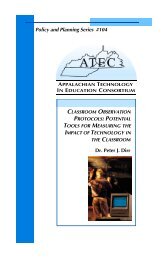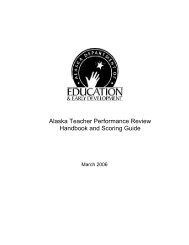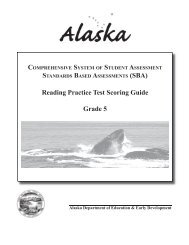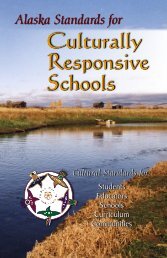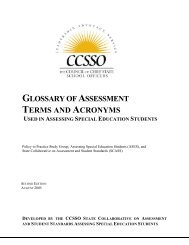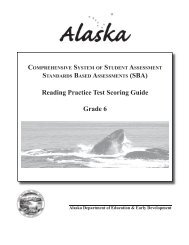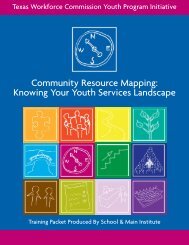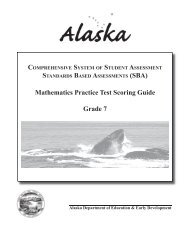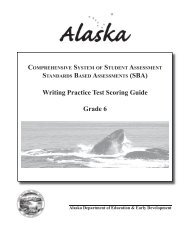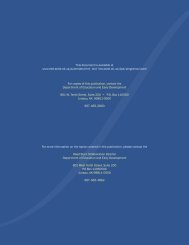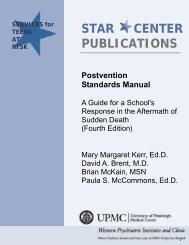Participation Guidelines for Alaska Students in State Assessments ...
Participation Guidelines for Alaska Students in State Assessments ...
Participation Guidelines for Alaska Students in State Assessments ...
Create successful ePaper yourself
Turn your PDF publications into a flip-book with our unique Google optimized e-Paper software.
STUDENTS WITH<br />
Limited English Proficiency<br />
LEP STUDENTS<br />
Mak<strong>in</strong>g Decisions about <strong>Students</strong> who are Limited English Proficient<br />
All students identified as Limited English Proficient (LEP) must participate <strong>in</strong><br />
statewide academic assessments. An LEP student is an <strong>in</strong>dividual whose first<br />
language is not English, or an American Indian, <strong>Alaska</strong> Native, or native resident<br />
who comes from an environment where a language other than English has had a<br />
significant impact on the <strong>in</strong>dividual’s level of English language proficiency [4 AAC<br />
34.090(a)(2)]. For the purposes of this guide, the term English language learner<br />
(ELL) refers to currently identified LEP students, not <strong>for</strong>mer LEP students. See<br />
the Guidance <strong>for</strong> Limited English Proficient Student Identification and Assessment<br />
on the department website at: www.eed.alaska.gov/tls/assessment/elp.<br />
html. <strong>Students</strong> identified as LEP must be provided reasonable accommodations<br />
on state academic assessments, to the extent practicable. Accommodations are<br />
allowed <strong>for</strong> LEP students when test<strong>in</strong>g <strong>for</strong> academic content knowledge and<br />
skills, but not when test<strong>in</strong>g <strong>for</strong> English language proficiency.<br />
Who makes the decision on LEP accommodations?<br />
Teams of people (teachers, adm<strong>in</strong>istrators, etc.) who know the educational<br />
needs of the LEP student should make decisions concern<strong>in</strong>g appropriate LEP accommodations<br />
to be used dur<strong>in</strong>g statewide content assessments. Teams should<br />
<strong>in</strong>clude a teacher or adm<strong>in</strong>istrator, when available, who has specialized tra<strong>in</strong><strong>in</strong>g<br />
or experience with limited English speak<strong>in</strong>g students and <strong>in</strong>struction. Because of<br />
the close l<strong>in</strong>k between assessment and <strong>in</strong>struction, the accommodations provided<br />
<strong>for</strong> the assessment should reflect those provided <strong>in</strong> classroom <strong>in</strong>struction and<br />
assessment. Research shows LEP students ga<strong>in</strong> <strong>in</strong> language acquisition yearly;<br />
there<strong>for</strong>e, accommodations should be reviewed accord<strong>in</strong>gly to reflect growth.<br />
Once a decision is made, it is essential to document the accommodations <strong>in</strong> the<br />
LEP student's file.<br />
What are ELL-responsive accommodations?<br />
The research-based LEP accommodations <strong>in</strong> Table 1 are ELL-responsive, i.e.,<br />
have been shown to support ELLs l<strong>in</strong>guistically <strong>in</strong> order to more accurately assess<br />
their academic content knowledge. Careful selection of ELL-responsive accommodations<br />
allows <strong>for</strong> mean<strong>in</strong>gful participation <strong>in</strong> content assessments and



